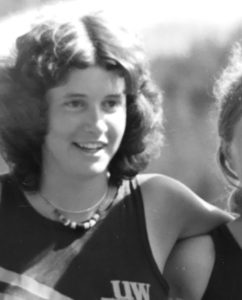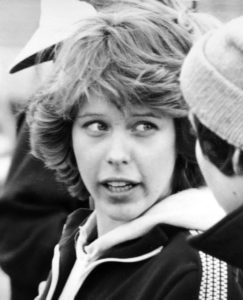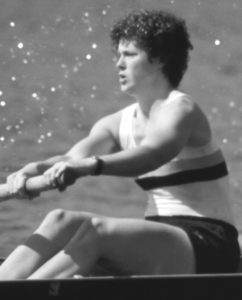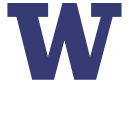By Eric Cohen, ’82
Honoring our captains at Washington is a tradition that goes back to the earliest days of the program. The Captain’s Wall – with photos of every athlete that has led the program since the beginning – serves as a connection to our past, and a reminder of those that have come before us.
But since women’s rowing became a varsity sport in 1975, missing from that wall have been the women’s captains who served their teams from 1975-1980. In 2017, the coaches and the Stewards decided to change that. “It is really important to our history” said Steward’s co-chair Jane Powers ‘85. “These are the pioneers of our sport, the leaders that built the program up from nothing.
Through extensive searching, conversations with alumnae, and ultimately some shot-in-the dark phone calls, by late spring these six Washington Rowing captains joined their peers on the wall at the shellhouse. They are: BJ Connolly and Nancy Michalson (1975); Kathy Bulger (1976, 1977); Linda Cox (1978); Jean Bulger (1979); and Lori Slehofer (1980).
This summer we talked with BJ, Kathy (now Kate Camber), and Linda (now Linda Cox Fornaciari), and asked them about their rowing experience, what it means to them today, and what they would say to the current athletes at the shellhouse:

BJ Connolly
Captain in 1975, BJ began rowing when the sport was still an intramural sport for women at Washington, and they rowed out of the old Navy Hangar on the Montlake Cut. “The old shellhouse was dark and cold but we did not care. Competition was strictly local against crews like Greenlake and LWRC. Who would have thought that by the end of my freshman year we would be winning the NWRA National Championship in the lightweight eight… to have been a part of those boats was an unbelievable experience. Because of our success that year, our coaches (Paula Mitchell and Colleen Lynch) approached Kit Green and Joe Kearney (the UW athletic director) and asked to make us an official varsity sport. They didn’t, but the next year (1972) we did row out of Conibear Shellhouse, which was a much better facility, but with it brought the challenge of being the first women’s team to share the shellhouse with the men.
By my senior year additional universities had also started their programs; UCLA, Cal, Oregon State; and we were all creating history for our schools: racing at the Western Sprints (prelude to the Pac 12 Championships), watching the National NWRA Championships grow and the best race of all: being the first Husky Women’s Crew to compete in Opening Day.
Coming from a broken home, the girls were like my second family. I did not see my father from the time I was 12 until my senior year at Washington. One afternoon at the shellhouse I was astounded to discover his name (Fred Mitchell ‘48) on the big W board, which caused me to contact him and share that I too, was now a Husky rower. Who would have thought? That connection changed our relationship. Whenever I see his Washington oar on my wall with its leather collar and brass fittings along with his photo as he sat in bow (his nickname was “The Rail” because he was 6’4 and thin)…..you can see the total joy on his face. I like to think that was one of his happier times.
Now being in my early 60’s I am still rowing and have been for the past 28 years. I never dreamed back then, that this would become a lifetime sport. Husky rowing taught me that life is all about connecting. People love to hear what rowing is all about and those that know the sport know that the tradition of excellence, giving of yourself 110% for a team effort and being able to handle the work load of training with studying are all challenges we overcome. And after you graduate, because of that you can handle any experience with fortitude and grace. The skills you learn as a rower will serve you for years to come! “

Linda Cox Fornaciari
Captain in 1978, Linda is the only coxswain added to the Captain’s Wall in this group. “I like to say that my four years as a coxswain was where I learned how to tell taller people what to do, and haven’t stopped since. But the truth is that Washington Rowing taught me the power of a group working together, and how each individual adds their particular strength to the whole to do what seems impossible. Quite frankly, once you have worked this hard and this many hours in the dark and rain, you have an innate confidence any place you go.
I became a corporate attorney and could always look anyone in the eye and think they never could have done the crazy early practices, the 100 sets of stadium stairs and work as hard as we did. You simply cannot be intimidated and you know you can work harder than anyone else in whatever you do. In the late ’70’s there was active opposition to women rowing by the men’s team… except for the few who were our friends. Title Nine brought us more equal benefits, but as the first group of women inducted into the Varsity Boat Club, we faced hostility.
The strong bonds we developed, knowing we could count on each person in our boat in a crunch, always pulled us through, in a race or any time we needed each other. We laughed and cried and figured out how to deal with the stress of being moved in and out of boats, clashes among teammates, and losing weight – – lightweight crew and coxswains were always hungry!
Six of us have gotten together once or twice a year for the 40 years since graduation, and we love seeing other teammates at UW events. My son and daughter tease me when I take pride in our Pac-8 Championships, given that it is the Pac-12 now. But I know that the amazing women rowing today for the UW are forging this confidence and strong connection with their teammates now. I hope they will treasure it and carry it with them forever. “

Kathy Bulger (Kate Camber)
Kate was elected captain in both 1976 and 1977 by her teammates, and for good reason: she was a leader both on and off the water throughout her career at Washington. “All of us loved rowing – to me it was the best part of my day… as a sport it is individual and it’s a team, I loved that part of it. It was where I could challenge myself but also so enjoy being a good rower; but what kept us going was we were doing something together at a level very few athletes get to. When you can rely on other people… and feel the swing together in the boat… those relationships stood above and beyond anything else in my life at the time.”
As captain in 1977, Kate was instrumental in bringing women into the Varsity Boat Club for the first time. “The men – most of them – did not like us being there. It was hard,” she said. In the spring of 1977 however, she prevailed in opening the VBC to women, and said at the time: “I am looking forward with a lot of hope” to being a VBC member. Sixteen women were inducted into the VBC for the first time that year.
Training changed season to season, but in the first years she said, “We never rowed on the ergs. In the fall we rowed in Old Nero and ran stairs, but I was one of the only rowers with previous experience (Kate rowed at Greenlake in high school under Kathy Whitman), so we did a lot of skill and drill because there were so many first-time rowers. In the spring we would race each other on the Evergreen Point floating bridge… we worked really hard.”
The highlight for Kate was not in the multiple NWRA Championships she won as a Husky, but the intrasquad racing on the Cut: “We didn’t have a lot of ham’n’egger’s, but they were an opportunity to be strong individually and meet the challenge of a completely random line-up. And my freshmen year… I just rowed for the enjoyment. It never occurred to me we would lose, and we didn’t. I felt powerful and had a sense of myself, people believed in me and I believed in them and we never said anything about it. There’s an ineffable quality about it.”
“I always remembered my rowing career as a really special time, it was my refuge, everything fell away, I didn’t have any problems. You have to be in the moment every moment when you are rowing. When I got into the rowing shell my life was perfect. And I was aware of that.
It was so beautiful. The sounds of the bubbles, on the cedar shells, Mt. Rainier, the sunrise over the Cascades – it was like music. When you have the run, and the drip, drip, drip off the oars… it was almost perfection.”







